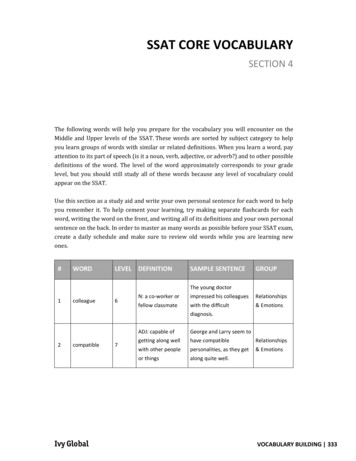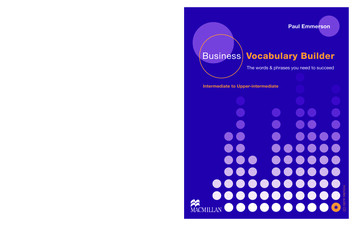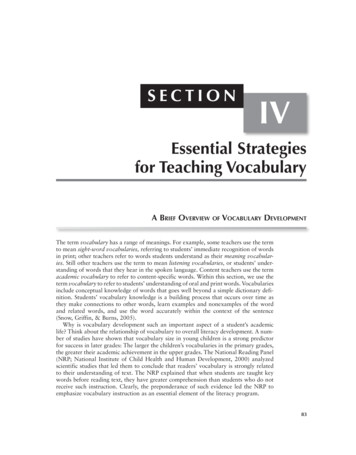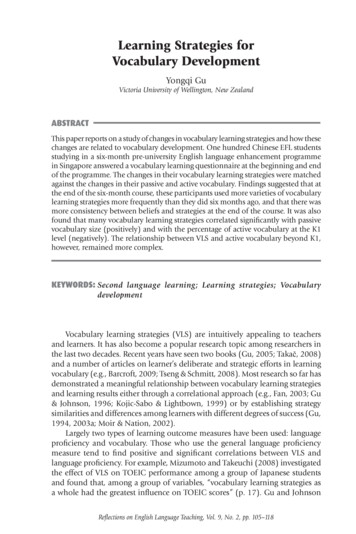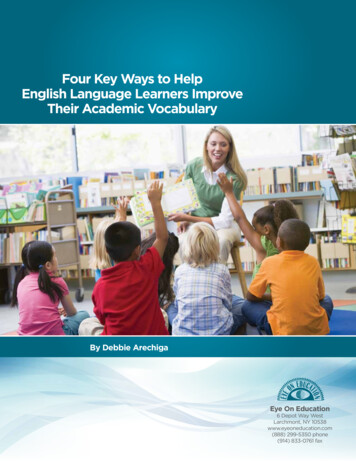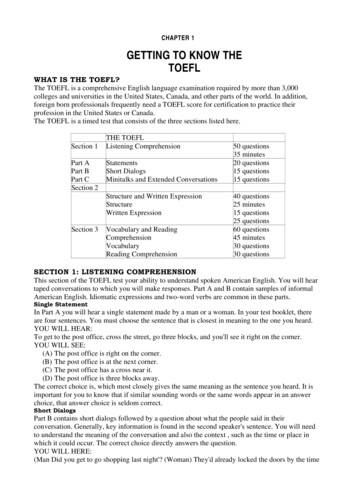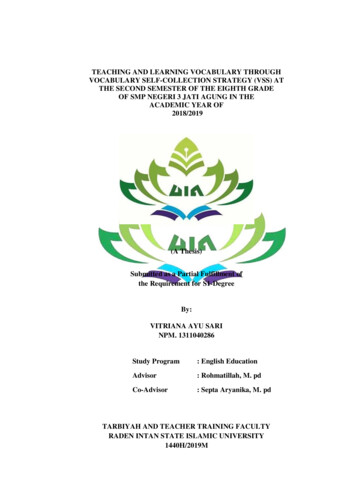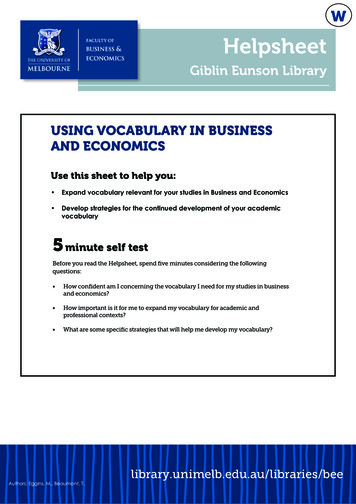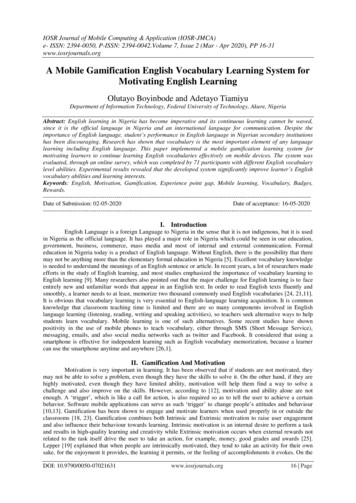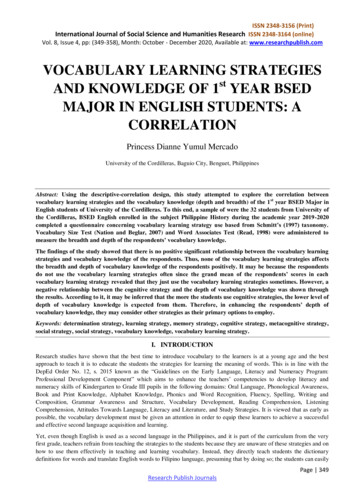
Transcription
ISSN 2348-3156 (Print)International Journal of Social Science and Humanities Research ISSN 2348-3164 (online)Vol. 8, Issue 4, pp: (349-358), Month: October - December 2020, Available at: www.researchpublish.comVOCABULARY LEARNING STRATEGIESAND KNOWLEDGE OF 1st YEAR BSEDMAJOR IN ENGLISH STUDENTS: ACORRELATIONPrincess Dianne Yumul MercadoUniversity of the Cordilleras, Baguio City, Benguet, PhilippinesAbstract: Using the descriptive-correlation design, this study attempted to explore the correlation betweenvocabulary learning strategies and the vocabulary knowledge (depth and breadth) of the 1 st year BSED Major inEnglish students of University of the Cordilleras. To this end, a sample of were the 32 students from University ofthe Cordilleras, BSED English enrolled in the subject Philippine History during the academic year 2019-2020completed a questionnaire concerning vocabulary learning strategy use based from Schmitt’s (1997) taxonomy.Vocabulary Size Test (Nation and Beglar, 2007) and Word Associates Test (Read, 1998) were administered tomeasure the breadth and depth of the respondents’ vocabulary knowledge.The findings of the study showed that there is no positive significant relationship between the vocabulary learningstrategies and vocabulary knowledge of the respondents. Thus, none of the vocabulary learning strategies affectsthe breadth and depth of vocabulary knowledge of the respondents positively. It may be because the respondentsdo not use the vocabulary learning strategies often since the grand mean of the respondents’ scores in eachvocabulary learning strategy revealed that they just use the vocabulary learning strategies sometimes. However, anegative relationship between the cognitive strategy and the depth of vocabulary knowledge was shown throughthe results. According to it, it may be inferred that the more the students use cognitive strategies, the lower level ofdepth of vocabulary knowledge is expected from them. Therefore, in enhancing the respondents’ depth ofvocabulary knowledge, they may consider other strategies as their primary options to employ.Keywords: determination strategy, learning strategy, memory strategy, cognitive strategy, metacognitive strategy,social strategy, social strategy, vocabulary knowledge, vocabulary learning strategy.I. INTRODUCTIONResearch studies have shown that the best time to introduce vocabulary to the learners is at a young age and the bestapproach to teach it is to educate the students the strategies for learning the meaning of words. This is in line with theDepEd Order No. 12, s. 2015 known as the “Guidelines on the Early Language, Literacy and Numeracy Program:Professional Development Component” which aims to enhance the teachers’ competencies to develop literacy andnumeracy skills of Kindergarten to Grade III pupils in the following domains: Oral Language, Phonological Awareness,Book and Print Knowledge, Alphabet Knowledge, Phonics and Word Recognition, Fluency, Spelling, Writing andComposition, Grammar Awareness and Structure, Vocabulary Development, Reading Comprehension, ListeningComprehension, Attitudes Towards Language, Literacy and Literature, and Study Strategies. It is viewed that as early aspossible, the vocabulary development must be given an attention in order to equip these learners to achieve a successfuland effective second language acquisition and learning.Yet, even though English is used as a second language in the Philippines, and it is part of the curriculum from the veryfirst grade, teachers refrain from teaching the strategies to the students because they are unaware of these strategies and onhow to use them effectively in teaching and learning vocabulary. Instead, they directly teach students the dictionarydefinitions for words and translate English words to Filipino language, presuming that by doing so; the students can easilyPage 349Research Publish Journals
ISSN 2348-3156 (Print)International Journal of Social Science and Humanities Research ISSN 2348-3164 (online)Vol. 8, Issue 4, pp: (349-358), Month: October - December 2020, Available at: www.researchpublish.comunderstand the unfamiliar words. Doing these do not enhance the vocabulary knowledge of the students because a word’sdefinition only provides a superficial understanding of a word. As a result, there are many older struggling readers who donot have very large vocabulary.Insufficient vocabulary may lead to the lack of communicative competence and lack of expressing ideas correctly. Theinability to expand the vocabulary will gradually result into the demotivating factors of the learners to learn the language;thus, competitiveness in the communicative level will be a continual issue or a loophole of the language itself (Tizon,2009).An aid for the language teachers to inject the vocabulary learning in the classroom is the unlocking of difficulties in thelesson planning as observed by the researchers during their practice teaching. The teachers define words that areunfamiliar to the students and have these used in a sentence but the context is not given emphasis that leads to rotelearning rather than a meaningful, direct, and purposive language learning.With this, the research was led to discover more about the vocabulary knowledge of the English major college students ofone of the biggest schools in Baguio, University of the Cordilleras. Furthermore, the researcher aimed to help the collegestudents because they must be equipped with sufficient vocabulary knowledge through the use of vocabulary learningstrategies that will be beneficial to them as they will soon be future educators, educating the next generation. Theresearcher put much interest in determining the correlation between vocabulary learning strategies and knowledge of the1st year English majors in University of the Cordilleras.II. REVIEW OF RELATED LITERATURESecond language learning largely depends on the vocabulary, as the building blocks from which learners start their secondlanguage (L2) acquisition. Hence, its significance lies inherently deep within the first stages of the acquisition of anylanguage (Ramos, 2015). As well-supported by years of research, vocabulary learning is a non-stop process. It is acontinual process of encountering new words in meaningful and comprehensible contexts.Lessard (2012) stated that vocabulary knowledge is known to be an important part to English language teaching. Withouthaving enough vocabulary, students will have a hard time communicating and understanding others. Accordingly, Daug(2013) said that enriching one's vocabulary is also empowering one's self. All the words contained in a human mindwaiting to be used in communication, it helps one to develop self-confidence.Meanwhile, according to Schmitt (2008), in order for a learner to be functional in the English language, his/hervocabulary should range from 8000-9000 word levels that he/she needs for reading purposes and a range of 5000-7000word levels for oral discourse purposes – and this does not always happen for most learners, because the responsibility ofvocabulary learning does not only lie to the learners’ part. Moreover, there is a predominant principle that learners canmaximize their vocabulary learning through being engaged with lexical items.Furthermore, Diamond & Gutlohn (2012) stated that vocabulary knowledge pertains to the ability of a learner to use aword in communicating with others. It is not something that can be mastered, instead, it is something that continuouslydevelops over time. It does not only involve consulting the dictionary to look up for the meanings of unfamiliar words,but more of indirect exposure and explicit instruction of words and word-learning strategies. As for the vocabularyknowledge, Shen (2008) wrote that it consists two dimensions which are breadth and depth. Breadth deals with the size orthe number of words that a learner has whereas the depth is concerned with quality or the words that a learner hasprofound understanding. Similarly, Bardakç (2016) mentioned that learners’ lexicon has two important aspects known asbreadth and depth of vocabulary knowledge. Breadth of vocabulary knowledge refers to linear and unidimensional aspectswhile depth is related not only to word meanings but also to semantic relationships, collocations and syntactic patterning.Maher (2008) investigated the relationship between vocabulary knowledge and reading comprehension of authenticArabic texts. Data were gathered from 23 learners at Brigham Young University, whose range were classified fromIntermediate Low to Intermediate. Two reading comprehension tests were used, for identifying unfamiliar words in textsand a lexical test for each passage texts were given to the participants. The data showed that there is a correlationcoefficient of 0.7 and 0.6 between the percentage of known words and students’ comprehension of the two reading texts.The results gave emphasis that the subjects needed to know approximately 90% of running words to understand the firstpassage and around 86% to comprehend the second passage. Also, Maher conceded that vocabulary knowledge isPage 350Research Publish Journals
ISSN 2348-3156 (Print)International Journal of Social Science and Humanities Research ISSN 2348-3164 (online)Vol. 8, Issue 4, pp: (349-358), Month: October - December 2020, Available at: www.researchpublish.comprerequisite and has a huge factor in understanding text. Also, there is a relationship between vocabulary knowledge andreading comprehension.Kaivanpanah and Zandi (2009) identified the role of depth of vocabulary knowledge in reading comprehension. A TOEFLtest and a measure of depth of vocabulary knowledge were administered to 57- 17 are males, while 40 are females of EFL(English as Foreign Language) learners. The analysis of the results showed that vocabulary knowledge is significantlyrelated to reading comprehension.Furthermore, Mehrpour et al. (2011) examined the relationship between vocabulary knowledge and readingcomprehension on EFL learner from among five language teaching institutes in Shiraz. The participants of the study weresixty-30 participant for both male and female. The results gathered from the analysis of the data showed that while bothdepth and breadth of vocabulary knowledge play an important role in EFL learners' reading comprehension performance,depth of vocabulary knowledge make a huge contribution. The results further discovered that depth and breadth ofvocabulary knowledge are positively related, that is, those learners who had large vocabulary size had also a deeperknowledge of the words.Zhang and Lu (2015), on their study “The Relationship between Vocabulary Learning Strategies and Breadth and Depthof Vocabulary Knowledge,” identified the correlation between vocabulary learning strategies and vocabulary breadth anddepth knowledge. 150 first-year university students in China took the Vocabulary Levels Test-a meaning recall task andthe Depth of Vocabulary Knowledge Test. The two consecutive instruments used were the tests that identifies thatparticipants’ meaning recognition and meaning recall which are both passive, while the last test was used to identify theparticipants’ depth of vocabulary knowledge. Participants also took a survey regarding their vocabulary learning strategiesusing the revised of questionnaire by Schmitt’s taxonomy. The researchers also used a structural equation in assessinghow vocabulary learning strategies predicted the depth and breadth of vocabulary knowledge. The results of the testshowed that strategies that focus the forms and meaning of the words from the text are great basis of both vocabularydepth and breadth knowledge.In addition, Orafi and Aljdee (2009) in their study entitled “Vocabulary Learning Strategies and Vocabulary Knowledgeamong EFL Tertiary Learners: Match or Mismatch?” tried to identify the range and frequency of vocabulary learningstrategies of the students in the two departments at Al:Zawia University in Libya. The participants of the study were allthe 4th year undergraduate students (112 students) majoring in English as a foreign language. They represented twoEnglish language departments in the cities of Zawia and Sabratha. In the study, the score averages of the five categoriesaccumulated total grand mean scores of 45 for Group A and 52 for Group B. This revealed that for the Group A the mostfrequently used vocabulary learning strategies are the determination strategies that received a score average of 56 andtheir least frequently used strategies are the metacognitive strategies which accumulated a score average of 40. While, forthe Group B it is the combination of determination strategies and cognitive strategies that has a score average of 58 andtheir least frequently used strategies are the social strategies which garnered a score average of 39.Using a vocabulary learning strategies questionnaire which is divided into five sections namely (1) memory strategies, (2)determination strategies, (3) social strategies, (4) metacognitive strategies, and (5) cognitive strategies, Orafi and Aljdee(2009) showed that the students in both departments used discovery strategies such as using dictionaries, and guessingmeaning from context more frequently than consolidation strategies such as practicing in groups or making word lists.Furthermore, Teng and Feng (2016), on their study “Assessing the Relationship between Vocabulary Learning StrategyUse and Vocabulary Knowledge,” attempted to explore the relationship between direct and indirect vocabulary learningstrategies along with the depth and breadth of vocabulary knowledge. To this end, a sample of 145 low proficiencystudents who learn English as a Foreign Language (EFL) completed a questionnaire regarding vocabulary learningstrategy use. Vocabulary Levels Test and Word Associates Test were used as instruments to measure the breadth anddepth of lexical repertoire respectively. The results indicated that direct strategies were frequently used by EFL studentsand indirect strategies were less frequently used strategies. The scores obtained by the students in the test on strategy usewere correlated significantly and positively with breadth and depth of vocabulary knowledge.III. METHODOLOGYDescriptive-correlational research design was used in order to determine the relationship between the vocabularyknowledge and vocabulary learning strategies of the 1st year college students.Page 351Research Publish Journals
ISSN 2348-3156 (Print)International Journal of Social Science and Humanities Research ISSN 2348-3164 (online)Vol. 8, Issue 4, pp: (349-358), Month: October - December 2020, Available at: www.researchpublish.comAccording to Ary (2010), descriptive research design uses instruments such as questionnaires and interviews to gatherinformation from groups of individuals to summarize the characteristics of different groups or to measure their attitudesand opinions toward some issue. On the other hand, correlational research design is defined by Calmorin (2012) as aresearch design that describes and predicts how variables are naturally related in the real world, without any attempt bythe researcher to alter them. Therefore, in this study, these research designs will be used to systematically summarize thevocabulary knowledge and vocabulary learning strategies of the respondents and to help the researchers determine theextent to which the two different variables are related to each other.The respondents of this study were the 33 students from University of the Cordilleras, BSED English enrolled in thesubject Philippine History during the academic year 2019-2020. The vocabulary size test used in this study wasformulated by Nation and Beglar in 2007. It is designed to identify an individual’s receptive vocabulary size. It iscomposed of 140 multiple-choice items that is divided into 14 parts, each part represents the 1000-word family level. Thewords at each level were selected properly so that they would be representative of all the words at that word family level.The vocabulary learning strategies questionnaire based on Schmitt’s (1997) taxonomy is composed of 42 statementsdivided into 5 categories of vocabulary learning strategies: thirteen statements on memory strategies (items 1-13), eightstatements on determination strategies (item 14-21), seven statements on social strategies (items 22-28), eight statementson metacognitive strategies (items 29-36), and six statements on cognitive strategies (items 37-42). The frequency of usewas measured with a 5-point Likert scale, ranging from 1 (never) to 5 (always).Bernardo and Gonzales in 2009 used the VLSQ based from Schmitt’s (1997) taxonomy for their study. In their study, itwas indicated that the questionnaire was tested and results showed that these items are reliable since there is a high levelof distinction among persons/items along the measured variable (Person Reliability 0.99; Item Reliability . 95). It wasalso pre-tested to a number of respondents to ensure clarity of items and directions.The researcher administered the procedure by using the population of the BSED English students currently enrolled inPhilippine History. The tests were taken simultaneously in one classroom. The researchers divided the tests into two partsso that the students will have enough time to answer the tests seriously and will not be bombarded with too many testitems that will cause the respondents to have mental fatigue. The respondents were given one meeting to take the 140item Vocabulary Size Test and another meeting to answer the two remaining instruments which is the 42 statements in theVocabulary Learning Strategies Questionnaire. The respondents took the tests and questionnaire for 2 hours.To determine the vocabulary learning strategies of the respondents, 5-point Likert-scale was used. The table below wasused to describe the respondents’ vocabulary learning strategies:Table 1: Vocabulary Learning StrategiesVocabulary Learning gnitiveLimits of Verbal DescriptionAlwaysOftenSometimesSeldomNeverTo determine the level of vocabulary knowledge of the respondents, frequency counts, percentages and frequencydistribution were used. The table below was used to describe the respondents’ level of vocabulary knowledge:Table 2: Breadth and Depth of Vocabulary KnowledgeBreadth of Vocabulary(limits of index)123-14088-12253-8718-520-17Descriptive LevelVery HighHighAverageLowVery LowDepth of Vocabulary(limits of index)141-160101-14061-10021-601-20Page 352Research Publish Journals
ISSN 2348-3156 (Print)International Journal of Social Science and Humanities Research ISSN 2348-3164 (online)Vol. 8, Issue 4, pp: (349-358), Month: October - December 2020, Available at: www.researchpublish.comIV. RESULTS AND DISCUSSIONThe questionnaire used is composed of 42 statements which were divided into 5 different strategies relative in the field ofvocabulary learning. These statements allowed the researchers to illustrate the vocabulary learning strategies of therespondents. Vocabulary knowledge plays a huge role in English Language Teaching and has been one of the mostimportant areas of focus in second language acquisition. According to Mahar (2008), vocabulary knowledge can help thelearner to comprehend written texts and reading can contribute to vocabulary growth.Table 3: Vocabulary Learning StrategiesStatements1. Study the word with pictures.2. Connect the word to your experience.3. Make a list of vocabulary in alphabetical for reviewing.4. Make a list of vocabulary arranged by topic or group for reviewing (e.g. animal,parts of body, flower)5. Try to use the new word at once after learning.6. Associate the word with other words you have learned.7. Review the word you have learned by spelling it aloud.8. Remember a word from its strange form, pronunciation or difficult spelling.9. Say the new word aloud when studying in order to easily remember.10. Remember the word by underlining the first letter.11. Learn the words by paraphrasing the words meaning.12. Learn the words of an idiom together.13. Use physical action when learning a word (Ex. You will dance to remember themeaning of the word “dance”).14. Analyze parts of speech (e.g. noun, verb, adjective).15. Analyze affixes and roots to guess the meanings of words (e.g. replay – remeans do it again).16. Use the pictures or gestures to understand the meaning of words.17. Guess the meanings of words form textual context.18. Look up a word in English - English dictionary.19. Look up a word in English – Filipino dictionary.20. Look up a word in Filipino – English dictionary.21. List vocabulary and review it.22. Ask the teacher to translate the meaning of a word that you do not understand.23. Ask the teacher for synonyms or similar meanings of new word.24. Ask the teacher to make a sentence by using the new word.25. Ask for the teacher to check your word lists for accuracy.26. Ask classmates for meaning.27. Discover the meaning through group work activity.28. Interact with native speakers.29. Use English media (song, movie, newspaper, leaflets, The Internet, magazines,etc.)30. Test yourself with word tests.31. Translate the meaning of the word from Filipino into English.32. Translate the meaning of the word from English into Filipino.33. Continue to study the word over time.34. Practice by doing vocabulary exercises (e.g. filling words in the spaces)35. Play vocabulary games.36. Try to speak or describe things in English.37. Learn the word through verbal repetition.38. Learn the word through written repetition.39. Take notes in class.40. Use the vocabulary section in your textbook.41. Listen to a tape of word lists.42. Keep a vocabulary notebook wherever you go.Mean3.413.272.75Verbal mesPage 353Research Publish Journals
ISSN 2348-3156 (Print)International Journal of Social Science and Humanities Research ISSN 2348-3164 (online)Vol. 8, Issue 4, pp: (349-358), Month: October - December 2020, Available at: www.researchpublish.comTable 3 revealed that the most frequently used vocabulary learning strategy, both with a mean score of 3.76, are the takenotes in class which is under the cognitive strategy and the use English media such as songs, movies, newspapers andmagazines which is under the metacognitive strategy. This is due to the fact that learners take notes in class to have areference that they may use as their reviewer for quizzes or examinations and that they are exposed to variousaforementioned English media. In contrast, the least frequently used vocabulary learning strategy with a mean score of2.42, is the listen to a tape of word lists under the cognitive strategy. As the result revealed, the learners prefer to listen toother English media such as songs rather than listening to tape of word lists.Breadth of Vocabulary KnowledgeVocabulary knowledge plays a huge role in English Language Teaching and has been one of the most important areas offocus in second language acquisition. According to Mahar (2008), vocabulary knowledge can help the learner tocomprehend written texts and reading can contribute to vocabulary growth.Shen (2008) defined breadth of vocabulary knowledge as the number of words that a person knows. Using the vocabularysize test updated by Nation and Beglar (2007), the researchers identified the respondents’ receptive vocabulary size orbreadth of vocabulary knowledge. It is composed of 140 multiple-choice items that is divided into 14 parts. Each partrepresents the 1000-word family level. Respondents’ scores can be regarded as a close approximation to the proportion ofwords in the test that they know. Their vocabulary sizes are leveled through very high, high, average, and low levelsTable 4: Level of Breadth of Vocabulary KnowledgeLevelVery ble 4 reveals the distribution of the respondents according to their breadth of vocabulary knowledge as seen in theresults of the vocabulary size test. It is shown in the table that 28 (87.5%) out of 32 (100%) respondents got their breadthof vocabulary knowledge ranged to the average level, which has the highest frequency among all the levels. Next to it isthe high level with the second highest frequency with 3 (9.4%), which means that out of 32 (100%) respondents, 3 (9.4%)got their breadth of vocabulary knowledge ranged to the high level. On the other hand, the level which got the thirdhighest frequency and percentage was the very high level where 1 (3.1%) respondents’ breadth of vocabulary knowledgewas ranged to. The level which got the least frequency was the low level with none (0.0%) out of 32 (100%) respondents.The results show that majority of the respondents’ breadth of vocabulary knowledge are under the average level with thehighest frequency and percentage of 87.5% of the respondents.Research on the amount of vocabulary needed for receptive use indicates that learners need around 6,000-word families toread novels written for teenagers, to watch movies, and to participate in friendly conversation. According to Nation(2006), around 8,000 to 9,000 words are needed to read newspapers, novels, and some academic texts. Majority of therespondents fall under the average level, ranging from 5,300 to 8,700 word families which is far from the standard rangerecommended by Nation (2006) for them to be able to read newspapers, novels, and some academic texts.This result may be caused by the respondents’ lack of exposure to vocabulary words that can increase their vocabularysize. Also, their academic strands may also have an impact to their vocabulary size which means that vocabulary isperhaps not given much priority in their chosen strandsDepth of Vocabulary KnowledgeDepth of vocabulary knowledge is defined as a learner’s level knowledge of various aspects of a given word, or how wellthe learner knows this word (Z. Shen, 2008). Richards (1976) identified seven aspects of word knowledge, and one ofthose aspects is association. Using the word associate test of Read (1998), the researchers measured the respondents’depth of vocabulary knowledge in two aspects: synonyms and collocation of words. The respondents’ depth of vocabularyknowledge is leveled through very high, high, average, and low levels.Page 354Research Publish Journals
ISSN 2348-3156 (Print)International Journal of Social Science and Humanities Research ISSN 2348-3164 (online)Vol. 8, Issue 4, pp: (349-358), Month: October - December 2020, Available at: www.researchpublish.comTable 5: Respondents’ Depth of Vocabulary KnowledgeLevelVery HighHighAverageTotalF226432%6.381.312.5100.0Table 5 shows the distribution of the respondents according to their depth of vocabulary knowledge as seen in the resultsof the word associate test. It is revealed in the table that 26 (81.3%) of the 32 (100%) respondents got their depth ofvocabulary knowledge ranged to the high level, which had the highest frequency among all the levels. Following it is theaverage level with the frequency of 4, meaning 12.5 % of the respondents got their depth of vocabulary knowledge placedunder the average level. Two (2) respondents got their depth of vocabulary knowledge ranged to the very high level or6.3% of the 32 respondents making it the level with the least frequency. This is similar to the results of their breadth ofvocabulary knowledge where the level which got the least frequency was the very high level as well. The low level wasnot included, for none of the respondents’ depth of vocabulary knowledge fell under this level. The results show thatmajority of the respondents’ depth of vocabulary knowledge are under the high level with the highest frequency andpercentage of 32, 81.3% of the respondents.According to Schmitt and Norbert (2014), there may be second language learners in an English class who knew arelatively small number of words, but knew them quite well which may be due to a particular study approach where thestudents study the words in textbooks, look them up in dictionaries, look for them in their readings, and practice themover and over. Probably the respondents apply this intensive approach in studying words which may be the reason behindtheir high level of depth of vocabulary knowledge.In line with this, using different vocabulary learning strategies may lead to a very different kind of learning. For example,studying the words in isolation without contextual elaboration limits the students to learning only something about theword form, something about the meaning, and some linkage between the form and meaning (Schmitt and Norbert, 2014).In this study, the percentage of the respondents who have high level of depth of vocabulary knowledge (81.3%) is higherthan the percentage of those who have high level of breadth of vocabulary knowledge (9.4%). These results suggest that itis possible to know a little about a larger number of words, or to know a great deal about a smaller number of words. Thatis, breadth and depth do not necessarily grow in a parallel manner.Relationship between the Vocabulary Learning Strategies and Vocabulary Knowledge of the RespondentsVocabulary learning strategies have great impact on the state of a learner’s vocabulary knowledge. Schmitt (1997) hasstated that vocabulary learning strategies are with great importance, affecting the vocabulary acquisition of the languagelearners. He
vocabulary learning strategies and the vocabulary knowledge (depth and breadth) of the 1st year BSED Major in English students of University of the Cordilleras. To this
